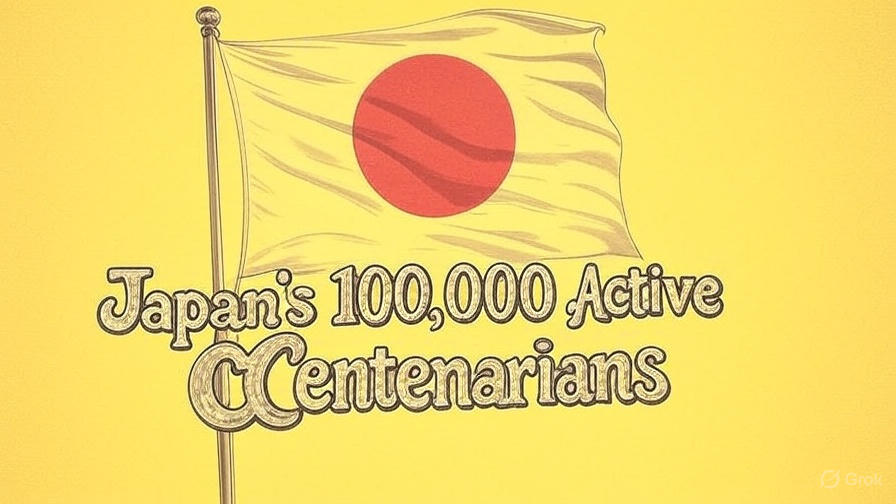Japan Reaches 100,000 Active Centenarians — A Global Longevity Landmark
Introduction
On October 1, 2025, the popular X account @DailyLoud shared a post that quickly went viral:
“Japan sets new record with 100,000 active citizens that are 100 years old.”
The milestone is more than just a statistic. It reflects decades of cultural practices, public health policies, and community-based habits that allow older adults in Japan not just to live longer — but to live healthier, more active lives.
This achievement raises critical questions about aging societies worldwide, offering both inspiration and a challenge to rethink what healthy longevity can look like.
Japan sets new record with 100,000 active citizens that are 100 years old pic.twitter.com/ib4iROVgUi
— Daily Loud (@DailyLoud) October 1, 2025
The Historic Milestone
Japan’s Ministry of Health, Labour and Welfare had already reported 99,763 centenarians as of September 12, 2025 — the 55th consecutive annual increase. Just weeks later, the figure tipped over to 100,000 active centenarians, underscoring a trend that has been decades in the making.
- Women dominate the statistic: Around 88% of Japan’s centenarians are female.
- Active aging is central: The term “active” refers to continued participation in daily activities — from physical exercise to community involvement.
- This landmark reflects not only longevity but vitality, making Japan a unique case study in global aging.
The Viral Tweet and Image
The tweet was paired with a vibrant photograph: Dozens of elderly Japanese citizens, many wearing hats, performing Radio Taiso — a traditional group exercise that dates back to 1928. They use wooden dumbbells, moving in unison in an outdoor public space, surrounded by greenery.
The image symbolizes discipline, community spirit, and collective well-being, which have long been pillars of Japanese health culture.
Why Japan Leads in Longevity
Experts attribute Japan’s exceptional life expectancy — one of the highest in the world — to a combination of biological, social, and cultural factors:
- Balanced Diet: Low in processed foods, rich in vegetables, fish, rice, and fermented dishes like miso.
- Daily Movement: Routine walking, cycling, gardening, and group activities such as Radio Taiso.
- Universal Healthcare: Accessible preventive care and long-term health monitoring.
- Social Cohesion: Strong community ties and intergenerational respect help reduce stress and promote mental health.
- Ikigai — A Sense of Purpose: Many older adults continue hobbies, work part-time, or volunteer, staying mentally and socially engaged.
Global Significance
Japan’s demographic achievement carries lessons — and warnings — for other countries facing rapid aging:
- Healthcare Policy: Rising numbers of older adults require sustainable care systems.
- Urban Design: Cities need to be age-friendly, with accessible transport and safe public spaces.
- Workforce Participation: Active seniors may help offset workforce shortages.
- Cultural Approach: Viewing aging as a phase of vitality rather than decline can reshape policies worldwide.
FAQs
Q1: Why does Japan have so many centenarians?
A mix of diet, healthcare, exercise habits, and social connectedness has supported healthy aging for decades.
Q2: Are these centenarians truly “active”?
Yes — many still engage in household tasks, community events, and light exercise, as demonstrated by the Radio Taiso gatherings.
Q3: Is Japan’s longevity trend sustainable?
Experts warn of challenges, such as the economic burden of an aging population, but cultural and healthcare infrastructure remain strong.
Q4: How does Japan compare to other countries?
Japan leads the world in centenarian density, followed by Italy, Greece, and certain “Blue Zones” like Okinawa — a Japanese region renowned for longevity.
Q5: What can other nations learn from Japan?
Investing in preventive healthcare, promoting active lifestyles, and fostering community belonging can improve health outcomes globally.
Opinion
Japan’s record of 100,000 active centenarians is both a triumph and a test. It demonstrates what is possible when a society prioritizes health, purpose, and social bonds — but it also highlights the pressures of supporting such a large elderly population in the decades ahead.
The milestone forces us to ask deeper questions:
- What does it truly mean to “age well” in the 21st century?
- Can other nations replicate Japan’s success without sharing its cultural history and dietary traditions?
- How do we balance celebrating long life with ensuring quality of life for all generations?
In an era when aging populations often evoke concerns about healthcare costs and shrinking workforces, Japan offers a counternarrative: that a well-supported elderly population can remain vibrant, productive, and socially engaged.
The lesson is clear — longevity should not be measured only in years, but in health, purpose, and community connection.


0 comments